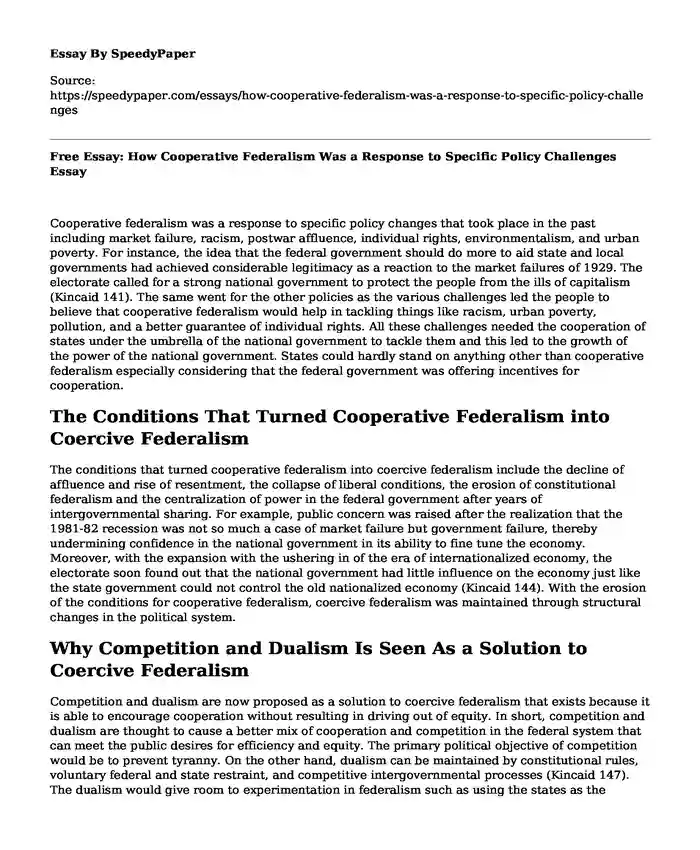
| Type of paper: | Essay |
| Categories: | Policy Federalism |
| Pages: | 3 |
| Wordcount: | 641 words |
Cooperative federalism was a response to specific policy changes that took place in the past including market failure, racism, postwar affluence, individual rights, environmentalism, and urban poverty. For instance, the idea that the federal government should do more to aid state and local governments had achieved considerable legitimacy as a reaction to the market failures of 1929. The electorate called for a strong national government to protect the people from the ills of capitalism (Kincaid 141). The same went for the other policies as the various challenges led the people to believe that cooperative federalism would help in tackling things like racism, urban poverty, pollution, and a better guarantee of individual rights. All these challenges needed the cooperation of states under the umbrella of the national government to tackle them and this led to the growth of the power of the national government. States could hardly stand on anything other than cooperative federalism especially considering that the federal government was offering incentives for cooperation.
The Conditions That Turned Cooperative Federalism into Coercive Federalism
The conditions that turned cooperative federalism into coercive federalism include the decline of affluence and rise of resentment, the collapse of liberal conditions, the erosion of constitutional federalism and the centralization of power in the federal government after years of intergovernmental sharing. For example, public concern was raised after the realization that the 1981-82 recession was not so much a case of market failure but government failure, thereby undermining confidence in the national government in its ability to fine tune the economy. Moreover, with the expansion with the ushering in of the era of internationalized economy, the electorate soon found out that the national government had little influence on the economy just like the state government could not control the old nationalized economy (Kincaid 144). With the erosion of the conditions for cooperative federalism, coercive federalism was maintained through structural changes in the political system.
Why Competition and Dualism Is Seen As a Solution to Coercive Federalism
Competition and dualism are now proposed as a solution to coercive federalism that exists because it is able to encourage cooperation without resulting in driving out of equity. In short, competition and dualism are thought to cause a better mix of cooperation and competition in the federal system that can meet the public desires for efficiency and equity. The primary political objective of competition would be to prevent tyranny. On the other hand, dualism can be maintained by constitutional rules, voluntary federal and state restraint, and competitive intergovernmental processes (Kincaid 147). The dualism would give room to experimentation in federalism such as using the states as the laboratory for democratic evaluation as well as fail-safe redundancies. Dualism can also serve an accountability function by helping the electorate to fix responsibility for policies thereby allowing state and federal officials to watchdog each other among others.
The Obstacles to This Form of Federalism
One of the obstacles to competition and dualism is the realization by the conservatives that federal power can serve their purposes while the liberals discover that states' rights can serve their objectives too in the form of state-court protections of individual rights under the "new judicial federalism." Another obstacle is the breakdown of the old ideological dichotomy between an inherently progressive federal government and in intrinsically backward state government might make federalism safe for a new consensus whereby cooperative equity, competitive efficiency, and dual accountability. Lastly, events taking place in other parts of the world may assist in consensus building (Kincaid 151). The belief or hope that a new form of federalism that is competitive and efficient can be found in the existing system stands as the obstacle to the federalism idea based on competition and dualism.
Word Count: 624
Work Cited
Kincaid, John. "From Cooperative to Coercive Federalism." The Annals of the American Academy of Political and Social Science 509 (1990): 139-152. www.jstor.org/stable/1046444.
Cite this page
Free Essay: How Cooperative Federalism Was a Response to Specific Policy Challenges. (2022, Feb 23). Retrieved from https://speedypaper.net/essays/how-cooperative-federalism-was-a-response-to-specific-policy-challenges
Request Removal
If you are the original author of this essay and no longer wish to have it published on the SpeedyPaper website, please click below to request its removal:
- Police Technology Essay Example
- Free Essay on the Ceramics of the Japanese Tea
- Free Essay Dedicted to David Hockney and His Connection to Modernism Movement
- Free Essay Example: Ethical Issues Analysis Outline
- Paper Example: Understanding the Reasons for Planning
- Paper Example: Characteristics of a Technical Document
- Paper Example - The Lives of the Peasants
Popular categories




